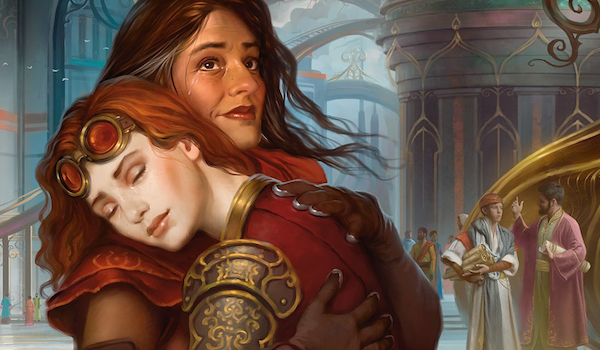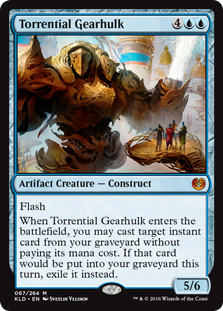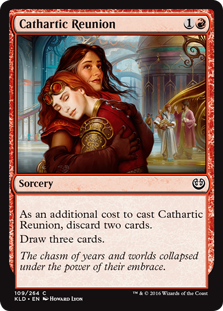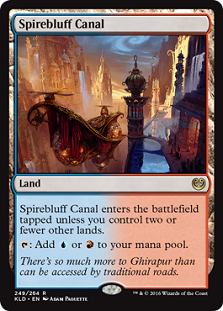Are you a Quiet Speculation member?
If not, now is a perfect time to join up! Our powerful tools, breaking-news analysis, and exclusive Discord channel will make sure you stay up to date and ahead of the curve.
It's that Friday again: the one where a new set becomes legal. The reception I've seen for Kaladesh has been surprisingly divisive, with some panning vehicles and others lauding the cycle of Inventions. For me, excitement surrounding a new set generally has to do with its constructed implications. My major takeaway from the Kaladesh spoilers was that for the first time since GP New Jersey '14, I would be able to register a decklist with eight spells that say "Draw 3 cards." Cathartic, indeed!

Chandra, Torch of Defiance and Verdurous Gearhulk have been talked about to death already, and I don't doubt we'll see both make a few waves in Modern. But I'm more interested in some of the less talked-about cards. Cathartic Reunion and Torrential Gearhulk are two that stand out to me as potential players in the format's future. In this article, I'll unveil a UR brew with each.
[wp_ad_camp_1]
Torrential Blue Moon
Blue Moon is a midrange deck that disrupts opponents with soft permission and its namesake enchantment before taking over the game with Batterskull, Thopter tokens, and the age-old Snapcaster-Bolt combination. The deck has recently included Goblin Dark-Dwellers in its arsenal. The Dwellers can flash back a burn spell (ideally Electroloyze) or grease the draw engine (with Ancestral Vision), but they require Blue Moon to tap five lands on its main phase and weaken it to enemy counterspells.
Torrential Gearhulk slots pretty easily into standard builds of Blue Moon, offering versatility as a flashed-in wall for attackers or as another functional copy of Goremand for those high-CMC spells that you just can't Bolt. Dark-Dwellers is its obvious counterpart, but Gearhulk doesn't just replace the 4/4---it fundamentally alters the way Blue Moon plays.
Blue Moon, by Jordan Boisvert
A New Moon
Torrential Gearhulk's most obvious apparent drawback compared to Goblin Dark-Dwellers is that it can't flash back Ancestral Vision, a sorcery. I don't think this is a huge issue since I would prefer not to play Vision in this deck at all. Modern is a format that rewards proactivity over reactivity, and Gearhulk's ability to begin applying pressure without warning---all without giving opponents a window to resolve their haymakers---softens the need for Vision in Blue Moon.
Previously, the deck could win with a big spell like Batterskull, but it often took games through sheer card advantage, ripping enough Bolts and functional Bolts to get to 20 damage after a few Snapcaster Mage attacks and many timely Logic Knots. This version of Blue Moon can escalate to 20 damage more quickly, improving the potency of tempo-centric counterspells like Goremand and negating our reliance on cards that bring us into the late-game. I don't know about you, but I'd rather just kill my opponent than draw a bunch of cards.
 Extra Bolts and Goremands are great, but we already have Snapcaster Mage for those. Torrential Gearhulk specifically shines brightest when he flashes back instants with a high converted mana cost. The Construct lacks Goblin Dark-Dweller's limiting "with converted mana cost 3 or less" clause, meaning it can nab anything from Spell Snare to to Giant Opportunity. In my build, I've opted to play expensive spells that can also be cast for cheap, so we don't dead draw too much in games without Gearhulk. I don't like leaning too heavily on flashing back Cryptic Command, a reactive spell; I'd rather capitalize on Gearhulk's ability to get really aggressive, really quickly.
Extra Bolts and Goremands are great, but we already have Snapcaster Mage for those. Torrential Gearhulk specifically shines brightest when he flashes back instants with a high converted mana cost. The Construct lacks Goblin Dark-Dweller's limiting "with converted mana cost 3 or less" clause, meaning it can nab anything from Spell Snare to to Giant Opportunity. In my build, I've opted to play expensive spells that can also be cast for cheap, so we don't dead draw too much in games without Gearhulk. I don't like leaning too heavily on flashing back Cryptic Command, a reactive spell; I'd rather capitalize on Gearhulk's ability to get really aggressive, really quickly.
Thunderous Wrath is my big spell of choice. 5 damage kills practically any creature in Modern, something few red spells can lay claim to---even Roast neglects the format's long roster of beefy fliers. Since Wrath also goes to the face, it combines with Gearhulk to help Blue Moon turn the corner at the drop of a hat. An end-of-turn Gearhulk on an empty field that flashes back Wrath before Blue Moon untaps and attacks presents a potential 10 damage out of nowhere. In a Bolt-Snap-Bolt deck, taking care of the other 10 damage shouldn't prove too difficult, especially with a 5/6 on the board.
Running expensive spells isn't all roses, though. Sure, Thunderous Wrath can cost a single mana with its miracle trigger. But we can also open it. Or, Keranos forbid, draw it off a Serum Visions! In these depressing scenarios, Jace, Vryn's Prodigy // Jace, Telepath Unbound, Izzet Charm, and maybe even the lone Desolate Lighthouse serve to loot the bad Wrath away. These cards, along with Thought Scour, also have the benefit of setting up miracle triggers on our opponent's turn.
Cathartic UR Delver
I won't lie (after all, I never do): I really think Temur Delver is where aggressive blue players want to be in Modern. My recent build of Monkey Grow has been performing very well, and whenever I try something else in a similar vein, I miss something about that deck enough to shelve whatever project distracted me.
 The following UR Delver list, then, is decidedly worse, mostly because it struggles against Burn and red-based sweepers while Monkey Grow avoids these weaknesses. Still, jamming games with it and similar shells has convinced me that Cathartic Reunion will see Modern play in some capacity, even if I don't have a perfect build on my hands. Before talking about the Delver deck specifically, let's take a look at Cathartic Reunion's overall positioning in Modern.
The following UR Delver list, then, is decidedly worse, mostly because it struggles against Burn and red-based sweepers while Monkey Grow avoids these weaknesses. Still, jamming games with it and similar shells has convinced me that Cathartic Reunion will see Modern play in some capacity, even if I don't have a perfect build on my hands. Before talking about the Delver deck specifically, let's take a look at Cathartic Reunion's overall positioning in Modern.
Evaluating Reunion in Modern
At its best, Cathartic Reunion pays like a good Brainstorm. Combined with a fetchland, Brainstorm allows casters to trade two bad cards in their hand for three new ones. But Reunion is not Brainstorm. Here's why:
- Brainstorm allows you to shuffle away blanks in the three cards drawn. Reunion forces you to ditch cards already in hand for cards that might be worse.
- Brainstorm can be cast at dire points in a game, such as during a topdeck war. Reunion asks you to have two cards in hand to discard. If one of those cards is one you want to keep in hand, you have to wait even longer to cast Reunion.
- Discarding is a cost for Reunion, making Spell Snare and Goremand incredibly mean answers to the spell.
- Reunion costs twice as much mana. Granted, many Modern decks would play a two-mana Brainstorm, but given the reasons listed above, Reunion isn't Brainstorm.
Reunion also has a couple benefits over Brainstorm in Modern, despite their marginality:
- Reunion is red, the color of Modern's best spell.
- Reunion doesn't rely on a shuffle effect to ditch the bad cards. Further, you're guaranteed to not draw those cards again, a bonus if you wanted to "shuffle away" useless fetchlands. These benefits are highly relevant in decks featuring Blood Moon, which turns fetches off.
 Okay, so Reunion isn't one of the most broken draw spells ever printed. But is it close enough to Brainstorm to be playable? Seeing three new cards for two mana is nothing special in Modern (see Anticipate and Telling Time), but drawing all three of those new cards is something we haven't seen at a cost this low since Ideas Unbound. Ideas has a few serious limitations---we need to cast the cards we draw this turn, and it carries an awkward double blue casting cost. I think it's safe to say Reunion is leagues better than this card.
Okay, so Reunion isn't one of the most broken draw spells ever printed. But is it close enough to Brainstorm to be playable? Seeing three new cards for two mana is nothing special in Modern (see Anticipate and Telling Time), but drawing all three of those new cards is something we haven't seen at a cost this low since Ideas Unbound. Ideas has a few serious limitations---we need to cast the cards we draw this turn, and it carries an awkward double blue casting cost. I think it's safe to say Reunion is leagues better than this card.
Where It Goes
When I see an interesting design on a card, I like to think about what archetypes or deck styles would want to play it.
Prison/Stompy: I've long used Faithless Looting in consistency-by-redundancy decks like GRx Moon to cycle away extra lock pieces or mana acceleration and find threats or relevant interaction. Even after it's been cast twice, once from the hand and once from the grave, Looting costs players a -1. Reunion is card-neutral, trading itself and two other cards for three cards. I think it will make a huge difference in this kind of deck. My builds with Chalice of the Void especially have wanted an efficient looting effect for a while, but were unable to pack Faithless Looting because of its damning converted mana cost of 1.
Graveyard synergy: For starters, Reunion is sure to see play in Dredge over the severely outclassed Tormenting Voice. Dredging a third card for the same amount of mana is huge in that deck, not to mention discarding another Prized Amalgam or Bloodghast stranded in an opener. Dredge is likely to be so stupid with Reunion that other graveyard-based decks fail to succeed in Modern at all, especially when players inevitably start packing more hate. But if any non-Dredge graveyard synergy decks start popping up in Modern utilizing Lingering Souls, Bloodghast, or whatever else, I wouldn't be surprised if players dipped into red for Reunion themselves. They're probably already red for Faithless Looting (and, of course, for Lightning Bolt).
Storm: Mid-combo, Reunion is practically Treasure Cruise for Storm decks, ditching lands accidentally drawn off Serum Visions and Probes for three shiny new cards. It can also dump spare copies of Pyromancer Ascension or Goblin Electromancer and help Storm set up for the big turn. I think this card is at least a serious upgrade to Desperate Ravings.
Low-curve aggro: A couple summers ago, a friend and I tried Faithless Looting in our Burn decks. The card was sometimes incredible, trading two lands in excess of our three in play for Bolt effects. But most of the time, it sucked. The big drawback to Looting in a critical-mass-style deck is that it costs a card, which Reunion doesn't. The draw spell is a little slow for Burn, but I can see it in a slightly more interactive sligh deck with bulkier threats (read: Tarmogoyf). I also tossed a set of Reunions into a UR Delver deck to give the card a shot alongside my favorite bug man. Actually, let's get to that.
UR Delver, by Jordan Boisvert
Evaluating Reunion in UR Delver
I tried UR Delver when Bedlam Reveler was spoiled and was mostly underwhelmed. Yeah, dumping our hand and cashing in with a Reveler feels great, but we can do that in Temur colors, too. Besides, omitting Traverse the Ulvenwald shoehorns us into playing 3-4 of the Devil so that we actually see it on time, and drawing multiple Revelers adds up to negate the advantage gained by casting one, since it will discard the others we're holding before we can resolve them, too.
Cathartic Reunion does a lot for this deck. It discards those extra Revelers to ensure they don't just go to waste, and it turns on Reveler's affinity clause more efficiently than Thought Scour or Traverse ever could. On a subtler note, Reunion allows us to play more lands.
 Obviously, Delver decks can manage on just two or even one land. But things are just better when we make multiple land drops. Making our first three land drops in Delver decks allows us to play an incredible game, mostly because we play so few lands in the rest of the deck. That means the majority of what we draw will be spells, and with a few lands in play to cast those spells, we end up doing many more "things" than opponents over the course of a game. One of the main draws to Traverse in Reveler strategies is that the Devil himself actually plays much better when his casters make their land drops during games.
Obviously, Delver decks can manage on just two or even one land. But things are just better when we make multiple land drops. Making our first three land drops in Delver decks allows us to play an incredible game, mostly because we play so few lands in the rest of the deck. That means the majority of what we draw will be spells, and with a few lands in play to cast those spells, we end up doing many more "things" than opponents over the course of a game. One of the main draws to Traverse in Reveler strategies is that the Devil himself actually plays much better when his casters make their land drops during games.
One primary tension here is that Delver of Secrets // Delver of Secrets demands players run as few lands as possible so that he transforms often. The other is that the commit-then-disrupt strategy doesn't work if after resolving threats and negating a threat or two, pilots find themselves drawing into lands instead of more Mana Leaks.
The first tension is easy enough to address: we just need to ensure we don't dip below 26 instants and sorceries in the deck. Once we've decided how many lands to run (let's start with the magic aggro number: 20), we can just cut into our creature count to accommodate more spells. The second is usually tougher, but Cathartic Reunion handles the issue admirably. If we draw too many lands, Reunion will just cycle them into business. It still taxes us two mana, but that cost isn't so steep when we've made our first three land drops. Running a suite of one-mana counterspells also helps mitigate Reunion's mana cost.
Blue Romance
Since the Twin ban, Modern players have clamored for blue to get a little respect from Wizards of the Coast. The Ancestral Vision unban helped, and so did Nahiri, the Harbinger. I think Torrential Gearhulk is just what the doctor ordered for durdly blue decks that can't access the planeswalker, and am excited to see if Cathartic Reunion makes an impact in blue decks, too (as long as we don't drown in a sea of Amalgams). Wizards can't please everyone, and they won't hit every demographic with Kaladesh or any expansion. But I raise my glass to them for printing so many interesting consistency tools lately, and specifically for showering me with cards featuring my three favorite words.




No Tarmogoyf? Booooo!
But apart from that, these look like spicy. I agree that Grow provides a more robust experience, as many tri-color decks do.
Im not too sure about Torrential Gearhulk.
I didn’t know we could run 6 drops in modern with 22 land. Especially without ramp.
Are you familiar with Turbo Xerox theory?
http://bopmtg-bopmtg.rhcloud.com/blog/turbo-xerox-rule
This deck has 16 cantrips that cost two mana or less.
I don’t think Torrential Gearhulk has a place in Modern. There’s no getting around the fact that the card is six mana in a color that does not run mana acceleration. Plus, in order for it to be a better value than Snapcaster Mage, you need to be flashing back instants with CMC 5 or more, and that’s just not something that happens in a format trying to kill you on turn 3. Card will be a house in Commander, but I do not see it making waves in Modern at all, unless there’s a good and reliable way to cheat it out early.
In terms of raw mana, you’re right—you need to flash back a spell with CMC 5+ to make Gearhulk more mana-efficient than Snapcaster. But you’re underestimating its 5/6 body, which puts a ton of pressure on opponents, and the pertinence of flash in combat. Dropping Gearhulk and blocking a Siege Rhino, all while flashing back another spell, actually nets you an additional 4 mana since you’re eating that threat for free.
As for acceleration, I don’t think it’s necessary if you pack enough disruption. Disrupting and acceleration (example: IoK and Hierarch) serve the same purpose in midrange decks: they bring the game to a state in which we can cast our higher-curve spells. 6 is a lot, but Blue Moon has been known to make plays like Snapcaster-Cryptic. But it’s certainly possible the deck needs more disruption or some acceleration to reliably make it to Gearhulk territory.
I would consider adding in a 23rd land. I think thunderous wrath is a good idea but perhaps just a little bit cute. I would prefer a more solid instant in that slot, like the 4th cryptic. Maybe also add electrolyze as it has incredible value when flashed back.
Thank you for the article! I have some questions about your evaluation of Reunion.
1. You note that the spell helps mitigate the risks of drawing multiple revelers in your delver list. I agree, but in prior work with reveler, your conclusion had been, iirc, that pitching one to play another was bad. Given that in this context, reunion and reveler do essentially the same thing, how is this problem somehow solved? Regardless of whether the method is a reveler or a reunion, we still discard one of our threats to play another.
2. Along the same lines, you also concluded that reactive spells and reveler don’t play well together. Given that your above list runs multiple reactive spells and a reveler playset, how does reunion fix this problem? Is simply doubling up on cycling tools enough to mitigate these tensions?
Oh one more. If it were the case that more cycling was the answer, why no prior lists using tormenting voice? Is the extra dig and discard by one card that significant?
It’s not the same. If you end up discarding a Reveler to casting another one, the first Reveler was a dead card you never got to use. When you discard it to Reunion, you trade it for another card that you can use, and then eventually play the second Reveler when you have no cards in hand.
1. Reunion doesn’t put you down on cards when it cycles spare Revelers. The Reveler puts you down one for each additional Reveler it discards.
2. Yes.
3. Yes.
I think Reunion will be good in Grixis delver to some extent. 2 Mana to draw three and discard additional delve creatures, which then also puts back “2” mana in delve resources
What’s the reasoning behind having the 2 thoughtscour in your torrential blue moon build?
Currently I’m trying your list out since I have all the cards, but instead of 2 thoughtscour im using 2 lava spike to make the deck that slightly more aggressive..